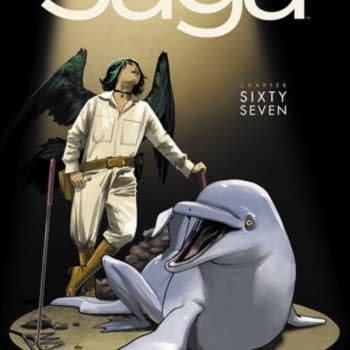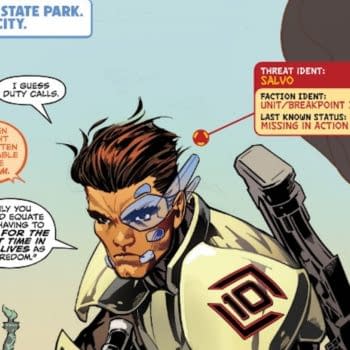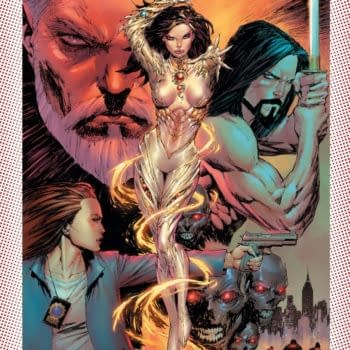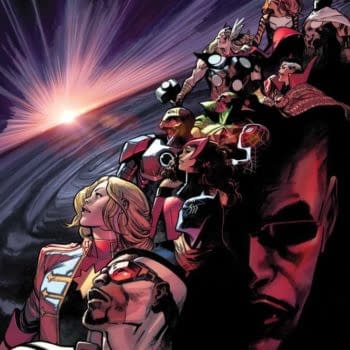Posted in: Comics, san diego comic con | Tagged: avatar press, Comics, entertainment, fevre dream, george rr martin, In The House Of The Worm, Skin Trade
Live With George RR Martin At San Diego Comic Con – Comics And Fantasy As Living Multiple Lives (UPDATE)
William Christensen of Avatar Press hosted George RR Martin on his work in comics in a massive turnout to Indigo Ballroom at the San Diego Comic Con. To thunderous applause, they kicked things off in what would be a discussion about fandom, writing, and creative choices that have led him to this point in life.
I am actually "the first comic book fan", Martin said. At a small comic con in 1964 in Greenwich Village, with Steve Ditko as guest, Martin kicked off his congoing life. His badge actually read #1, as the "first comic fan". Talking about short form versus long term writing, Martin said that he's never quite certain whether something will turn into a massive seven volume series.
Martin said he grew up "reading this stuff" regarding fantasy, and you write what you read, which led him to his work. He was born in Bayonne, New Jersey, a town where people stayed put, a town where his family had lived for "multiple generations". His world was "five blocks long" he said and he "never went anywhere", which prompted a "hunger" in him at an early age to get out of that limited space. Fantasy and comics took him across time and space, to "fabulous cities", like Gotham, and later an even weirder one, New York City when Marvel "came along".
"I think one of the things that fiction fulfills for us is vicarious experience", he said, and that reading books takes you through multiple universes and lives, all "through the wonders of fiction and imagination".
He had an allowance of a dollar a week as a kid that would buy him 10 comic books, and reading prose fantasy books finally stretched his budget, and he'd buy paperbacks off the spinner racks. He liked The Puppetmasters, one of the "scariest alien invasion" stories, which remained a favorite. Isaac Asimov was a discovery, and he moved through some writers who were "incomprehensible", but Jack Vance turned his head as "one of the greatest sci-fi fantasy masters of his day who was doing great work into his '90's and I hope to emulate him", Martin said.
Martin's favorite comics in the 1950's, as a young kid, he read all the DC superhero comics, "National Periodical Publications" as they were called at the time. The Flash, Green Lantern, The Atom, were characters he encountered. Comics were "more varied" in genre during that time, including war comics, westerns, and romance comics (which had girl cooties). He read the Harvey Comics and then got "too old and sophisticated" for those. There were "hotrod" comics and racing comics, and he was a big fan since his family didn't own a car and the fantasy element grabbed him. At a certain point after buying sci-fi novels, he stopped reading comics for a year or two, but then encountered a comic spinner rack, and he noticed a "weird looking comic" called The Fantastic Four.
It caught his attention because they had a monster on the cover and yet they seemed to be a group of heroes. He bought #4, then went to get the previous three, but it was difficult to get back issues in those days. That got him reading comics again, "just in the nick of time", so he was there when Spider-Man appeared, who he liked. He wrote a fan letter to Fantastic Four, and it was published. It listed his address, and he started getting fan letters in common with his own views and fanzines in the mail. They were printed in mimeograph machines.
Many of the 'zines were analysis, and some were original comic stories that fans had made themselves. Some were good, though there were a lot that were "wretched and semi-literate", which led him to say words that "changed his life forever", "Even I could do better than that". Thus he was launched as an "amateur comic writer".
Christensen asked what Martin sees as the difference between science-fiction and fantasy. Martin said he feels the difference is "insignificant" and those who believe they are polar opposites are usually sci-fi writers who feel sci-fi is more "significant". As a kid, he read both from one day to the next. Lovecraft and Asimov were both all "weird stuff" to his parents' mind, and he was happy with that grouping. In that time and previous decades, writers moved easily between those genres and blended, but in today's "publishing climate, people have built walls that are artificial", he said. The "only difference is the furniture", he said, and it doesn't matter, he said, "It's the characters that matter". This resulted in a big round of egalitarian applause.
Christensen asked Martin how he defines strong and weak characters and how he develops characters in his work. Martin looks for a "level of complexity in real human beings that we have to try to capture as a writer", he said. Sometimes we are both villains and heroes, "the same thing at the same time" as humans, he explained. Watching TV and seeing the perfect hero or overly dark villain makes him react with feelings of "I don't like that". The truth is, he said, "A lot of that goes back to Stan Lee and those early Marvel Comics". When he first encountered the Fantastic Four, they had "real conflicts" and the Thing hated being the Thing and there was a "real streak of violence in him". Characters came to blows and had conflict, including "rage" in the Thing directed towards Reed Richards for not curing him. There was also "sexual tension" that he didn't pick up on as a kid. The "human heart in conflict with itself" is a mantra that sticks with Martin and he saw this in early Marvel characters. They had a "depth" that DC Comics characters at that time didn't have. This got him addicted to "grey characters".
Martin told the story of a comic issue with a "grey, conflicted character" who seemed to be a hero to the outside world, but really a villain, and when it comes to the point of killing someone, he just can't do it, then dies heroically. That has tremendously influenced Martin's whole body of work. The conversation shifted toward the death and resurrection tendency in comics, which Martin found humorous.
Christensen asked if Martin has a hard time killing off characters that he really likes. He does find it difficult, but it serves the story, he said. Minor characters he's happy to kill off in droves, but he always tries to give them a "little something" so they aren't just "spear carrier #7. When he worked on Beauty and the Beast, Linda Hamilton left the show. They decided it would be most dramatic to write her out, kill off the character, and bring in a new "beauty". The network supported them in killing her, but wanted them to "get past it" very quickly. The following season was a search for her murderer and vengeance and the network hated this. They said, "People don't want to be sad. Don't have all this mourning stuff and grief. Get revenge the same episode and go on to new adventures". They had a "huge fight" over that issue with the network. Artistically, they were "right" he said, since "death should matter". "Death should hurt", he said, just as when you lose a parent or friend. It's a "wrenching event that makes us weep and we can't easily shrug us aside", he explained. The truth was, the network was somewhat right because the ratings "fell off a cliff" and people didn't want to be sad.
Martin had some of the same fear with Game of Thrones killing off Ned Stark and watched to see if ratings fell away. He speculated that a modern audience may be more "bloody" than in 1989. Death should not be a "break", he said, "I want my readers to feel emotions. That's what fiction is all about. Fiction is about emotion". He wants people to laugh, cry, be scared, he said, addressing the audience as "you". Not all the emotions can be good ones, he commented, and "I want to make you feel those too". This resulted in another floor-wide round of applause.
Christensen asked about Martin's history of involvement in fandom and shows, and why Martin has displayed so much commitment to engagement. "I am a fan", he said. His first San Diego Comic Con was in the 80's. For him "there's always been a sense of coming home", and meeting friends at conventions. He met his wife at a convention. His wife has said that the first time she attended a convention it felt like "At last, my people. I have found you". People ask him why he comes to comic con. It's an excellent place to promote one's work, he said. But he also goes to small conventions all over the country, as small as 500 people, and he goes because he "had fun at those conventions". He had to admit, though, that there's a "dark side" to the celebrity he's now achieved at shows. You can't "relax and have a drink with friends" and the fact that he can't "walk the floor at comic con" saddens him. He can no longer go and look at the new comics, and he appreciates the support he receives, but it has "changed the way he experiences the conventions", which does make smaller cons more appealing.
Christensen brought attention to Martin's "novella", In the House of the Worm, that Martin wrote in the 80's when he was still living in Chicago. He was reading and wanting to write for magazines like Galaxy and Analog, but also wanted to sell to Universe as well, so he kept sending in stories that were rejected. Until this one. It's set in a far galaxy where the sun is going out, and it's a "decadent" society where there's a hedonistic life with tunnels below, "lost in darkness". The story was finally picked up, and it was published in an anthology rather than in Universe. When Christensen asked to buy it, Martin pointed out that half the story happens in "blackness" and he wondered how it could be rendered in comics. "It's a novella that I've always been pleased with", and he hopes we will too. It's been a long process to render. Ivan Rodriguez was the artist on Doktor Sleepless before being picked up by DC, which kept him busy and took a long time to bring out the comic monthly.
The adaptation was done by Martin's friend John Miller, one of Martin's "Wild Card" writers. Christensen asked what it's like seeing your work adapted into a totally different medium. Martin said there's "anxiety" when you turn things over to someone else. You could get something "beautiful" or "really bad", like taking a kid to school for the first time and worrying what's going to happen to him there. That's true whether a movie deal or a comic deal, anything "turning your work over to other people", he said. You "select your people well", he said, and hope it turns out for the best. Ideally, he said, "the best comic adaptation bring the words to live but also add something, images the reader might never have thought of". It never "quite matches" the original story for Martin, and he'll always prefer the original story. In the case of Game of Thrones, it's great, he said, that so many people who have enjoyed the show have gone on to read the "original version" books which are larger and more detailed, more "complex". And that's also the case with In the House of the Worm.
Christensen brought up the previously collected comic series Martin created called Skin Trade (also from Avatar Press) which is essentially "horror" and Martin clarified that he's often used horror in his work, mixing elements. Skin Trade is a noir story with a private detective Werewolf set in a decaying Midwestern city. He was working a lot in Hollywood at that time and didn't want to "lose touch" with his "roots" in writing. He was working on Twilight Zone and hoping to contribute to a publisher called Dark Harvest. Each writer was asked to contribute 30,000 words of horror fiction, broken into whatever units they wanted to use. Martin produced one 30,000 word novella. He was also working on Night Visions, and one of the contributors was Stephen King and he wanted to be in the same volume as King. He "blew the deadline" which he "still does all the time", he confessed to laughter, but he was given extra time. His "vampire thing" called Fevre Dream, had been written a few years earlier, and this was his werewolf story. It's still "one of his favorites" among his novellas.
These books are available at Avatar Booth #2701 where many of the books have been "defaced" by Martin and signed.
Christensen wrapped things up by asking for advice for aspiring writers. Martin answers a lot of questions about this subject on his website in Q&A he said. He's found that lots of aspiring writers read a lot but "read very narrowly". Reading only sci-fi/fantasy or superheroes is fine, but not wide-ranging. He also reads classic literature, mystery and crime books, and the "more you read the more you see the different techniques being used". He said read widely, voraciously every day and simply "don't give up". He commented that many writers who were his contemporaries have "vanished" now. He could have given up, but didn't.
"It's not a career with security", he confessed, "You have to be a bit of a gambler". He had been at points of great success in the past, like the 70's and he thought he was "hot shit". Then he wrote a single novel that sold badly and it ruined his career and made him "yesterday's news". He had to come back from that. He said to ask yourself if you're going to write whether it ever sells or not because you have to, then you are actually a writer. If you can give it up, do, but if you can't, you must, he said in closing.
And here are some photos of fans lining up just to watch Martin exit and head to his car after the panel. Martin madness!
























